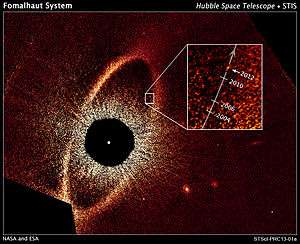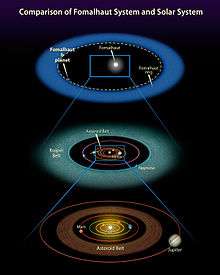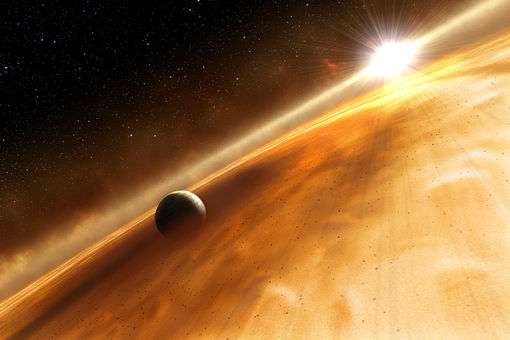Fomalhaut b
| Exoplanet | List of exoplanets | |
|---|---|---|
 | ||
| Parent star | ||
| Star | Fomalhaut | |
| Constellation | Piscis Austrinus | |
| Right ascension | (α) | 22h 57m 39.1s |
| Declination | (δ) | −29° 37′ 20″ |
| Apparent magnitude | (mV) | 1.16 |
| Distance | 25±0.1 ly (7.66±0.04 pc) | |
| Spectral type | A3V | |
| Mass | (m) | 1.92±0.02 M☉ |
| Radius | (r) | 1.842±0.019 R☉ |
| Temperature | (T) | 8,590 K |
| Age | 0.44±0.04 Gyr | |
| Orbital elements | ||
| Semi-major axis | (a) | 177±68[1] AU |
| Eccentricity | (e) | 0.8±0.1[1] |
| Orbital period | (P) | ~1700[1] y |
| Inclination | (i) | −55±14[1]° |
| Longitude of the node | (Ω) | 152±13[1]° |
| Argument of periastron |
(ω) | 26±25[1]° |
| Discovery information | ||
| Discovery date | November 13, 2008 | |
| Discoverer(s) | Kalas et al.[2] | |
| Discovery method | Direct imaging | |
| Discovery site | Hubble Space Telescope | |
| Discovery status | Replicated (Galicher et al., Currie et al.)[3][4] | |
| Other designations | ||
Dagon, HD 216956 b[5] | ||
| Database references | ||
| Extrasolar Planets Encyclopaedia | data | |
| SIMBAD | data | |
| Exoplanet Archive | data | |
| Open Exoplanet Catalogue | data | |
Fomalhaut b, also known as Dagon, is a confirmed,[4] directly imaged[2] extrasolar object and candidate planet orbiting the A-type main-sequence star Fomalhaut, approximately 25 light-years away in the constellation of Piscis Austrinus. The object was initially announced in 2008 and confirmed as real in 2012 from images taken with the Advanced Camera for Surveys (ACS) on the Hubble Space Telescope and, according to calculations reported in January 2013,[6][7] has a 1,700-year,[1] highly elliptical orbit. It has a periastron of 7.4 billion km (~50 AU) and an apastron of about 44 billion km (~300 AU). As of May 25, 2013 it is 110 AU from its parent star.
The planet was one of those selected by the International Astronomical Union as part of their public process for giving proper names to exoplanets.[8][9] The process involved public nomination and voting for the new name.[10] In December 2015, the IAU announced the winning name was Dagon.[11] The name Dagon was proposed by Dr. Todd Vaccaro and forwarded by the St. Cloud State University Planetarium to the IAU for consideration.[12] Dagon was a Semitic deity, often represented as half-man, half-fish.[13]
Summary
The nature of Fomalhaut b was at first unclear. It was thought it could be a conglomeration of rubble from a recent collision between comet-to-asteroid-sized bodies, and not actually a planet.[3] Although this scenario is possible, the likelihood of observing such a collision at the location of Fomalhaut b is extremely low. Instead, Fomalhaut b is plausibly, even probably, a planet less than twice Jupiter's mass that is either enshrouded in a spherical cloud of dust from ongoing planetesimal collisions[4][14] or surrounded by a large circumplanetary ring system,[2] either of which are responsible for scattering the primary star's light and thus making Fomalhaut b visible.
Fomalhaut b and three companions around HR 8799, whose discovery was announced simultaneously, were described as the first directly imaged extrasolar planets[15] (among earlier claims such as e.g. 2M1207 b, GQ Lup b, DH Tau b, AB Pic b, CHXR 73 b, UScoCTIO 108 b, CT Cha b, 1RXS 1609 b) in that their emission was thought to originate at least in part from a planetary atmosphere. However, subsequent studies from the Spitzer Space Telescope[16] and a reanalysis of the original HST data[3][4] instead suggest that Fomalhaut b's light is scattered starlight, not planet thermal emission.
Initial discovery by Hubble

The existence of a massive planet orbiting Fomalhaut was first inferred from Hubble observations published in 2005 that resolved the structure of Fomalhaut's massive, cold debris disk (or dust belt/ring).[17] The belt is not centered on the star, and has a sharper inner boundary than would normally be expected.[18] A massive planet on a wide orbit but located interior to this debris ring could clear out parent bodies and dust in its vicinity, leaving the ring appearing to have a sharp inner edge and making it appear offset from the star.[19]
In May 2008, Paul Kalas, James Graham and their collaborators identified Fomalhaut b from Hubble/ACS images taken in 2004 and 2006 at visible wavelengths (i.e. 0.6 and 0.8 µm). NASA released the composite discovery photograph on November 13, 2008, coinciding with the publication of Kalas et al. discovery in Science.[2][20]
Kalas remarked, "It's a profound and overwhelming experience to lay eyes on a planet never before seen. I nearly had a heart attack at the end of May when I confirmed that Fomalhaut b orbits its parent star."[20] In the image, the bright outer oval band is the dust ring, while the features inside of this band represent noise from scattered starlight.[21]
Early follow-up observations and doubts
In the discovery paper,[2] Kalas and collaborators suggested that Fomalhaut b's emission originates from two sources: from circumplanetary dust scattering starlight and from planet thermal emission. Here, the former explains most of the 0.6 µm brightness and planet thermal emission contributes to much of the 0.8 µm brightness. Their non-detections with ground-based infrared data suggested that Fomalhaut b had to be less massive than about 3 Jupiter masses.
However, Fomalhaut b should be detectable in space-based infrared data if its mass is between 1-3 Jupiter masses. But sensitive infrared Spitzer Space Telescope observations failed to detect Fomalhaut b, implying that Fomalhaut b has less than 1 Jupiter mass.[16] Furthermore, although the planet was thought to be a plausible explanation for Fomalhaut's eccentric debris ring, measurements in the Kalas et al. paper hinted that it was moving too fast (i.e. not apsidally aligned) for this explanation to work. Finally, researchers analyzing September–October 2011 Atacama Large Millimeter Array (ALMA) data for Fomalhaut's debris ring suggested an alternate hypothesis: that the ring could be shaped by much smaller, shepherding planets, neither of which needed to be Fomalhaut b.[22][23] These results invoked skepticism about Fomalhaut b's status as an extrasolar planet.[24][25]
Independent replication of the discovery and additional findings
In 2012, two teams working independently from each other and from the Kalas group downloaded the publicly available Hubble Space Telescope data and replicated the discovery of Fomalhaut b. One study led by Raphael Galicher (Herzberg Institute of Astrophysics) was submitted to The Astrophysical Journal on August 9, 2012. In addition to replication, they detected Fomalhaut b in a third HST filter (0.4 µm) and also claimed that it has an extended morphology in one of the three filters (0.8 µm). They considered two models to explain the observations: (1) a large circumplanetary disk around a planet and (2) the aftermath of a collision during the past 100 years of two Kuiper belt objects of radii about 50 km.[3] A second study was submitted on September 9, 2012, to The Astrophysical Journal Letters, led by Thayne Currie (University of Toronto). Currie et al. also detected Fomalhaut b in the third filter (0.4 µm) but did not find evidence for an extended morphology. They modeled the optical detections and infrared upper limits for Fomalhaut b, showing that Fomalhaut b's emission can be completely explained by starlight scattered by small dust and arguing that this dust surrounds an unseen planetary-mass object. They interpret Fomalhaut b as a "planet identified from direct imaging" even though photons emitted from the planet itself are probably not directly detected.[4]
The revival of the claim that Fomalhaut b is (possibly) a planet after it had been discounted led some to nickname the object a "zombie planet",[26] although this is a non-technical term used in press material and does not appear in any peer-reviewed manuscript.
Physical characteristics
Assuming that Fomalhaut b's orbit is in the same plane as the debris disk located exterior to it, it orbits Fomalhaut at a distance of approximately 115 AU (1.72×1010 km; 1.07×1010 mi). This distance is about 18 AU (2.7×109 km; 1.7×109 mi) closer to the star than the inner edge of the debris disk.[27] The orbital separation of Fomalhaut b is larger than that for directly imaged planets around β Pictoris and HR 8799 (8–70 AU). Fomalhaut b appears to be moving at about 4 kilometers per second.[4] It is unclear whether Fomalhaut b's orbit will make it cross the debris disk, cross the debris disk only in projection (i.e. it is not orbiting in the same plane as the disk), or whether its orbit is completely nested within the debris disk.[3][4]
At the optical wavelengths at which Fomalhaut b is detected, it is only about 2.7×10−10 times as bright as the star and is the faintest (intrinsically) extrasolar object yet imaged.[2] The shape of its spectrum, as determined from measurements obtained at 0.4 to 0.8 µm, appears similar to that of its host star, suggesting that the emission identifying Fomalhaut b is completely due to scattered starlight.[3][4] Although the initial discovery paper for Fomalhaut b suggested that its optical brightness may be variable due to planetary accretion, later reanalyses of these data fail to find convincing evidence that Fomalhaut b is indeed variable,[3][4] thus eliminating evidence for planetary accretion and also for a 'transient' dust cloud.
In order for Fomalhaut b to be detectable at optical wavelengths, it must have an emitting area much larger than the physical size of a planet,[2] a fact further strengthening the case that what we see as Fomalhaut b is not light coming from a planet atmosphere. A circumplanetary ring system is large enough to scatter enough starlight to make Fomalhaut b visible only if it has a radius between 20 and 40 times that of Jupiter's radius.[2] A spherical cloud of dust with a radius of 0.004 AU (600,000 km; 370,000 mi) can make Fomalhaut b visible.[4] Fomalhaut b appears as an unresolved point source in the highest-quality data (at 0.6 µm) which would suggest that its projected emitting area cannot be larger than about 0.25 AU, about 1/4th of the Earth–Sun distance.[2][4] However, it may be resolved at slightly longer wavelengths, indicating that its emitting area is larger.[3]
The mass of Fomalhaut b, if a planet, is highly uncertain. Infrared non-detections suggest that Fomalhaut b cannot be more massive than 2 times Jupiter's mass[4][16] but a lower limit on the mass depends on uncertain details for the nature of Fomalhaut b, its circumplanetary environment, and the existence of other planetary-mass bodies in the system. Models of Fomalhaut b sculpting the star's debris disk give a mass 0.5 times that of Jupiter. Models for Fomalhaut b assuming it is surrounded by a swarm of planetesimals imply that it could be much lower mass (10–100 times the mass of Earth).[14] If Fomalhaut b is instead one of two shepherding planets that together confine the debris disk into a narrow ring,[22] it could be anywhere between several times the mass of Mars to slightly more massive than Earth.
If Fomalhaut b is a gas giant like Jupiter or Saturn, it probably formed several million years after the host star itself was formed, making it roughly 450 million years old.[28] Alternatively, if it is a transient dust cloud it must be extremely young,[4] perhaps having formed within the last few centuries.[3]
Other planets orbiting Fomalhaut
Fomalhaut b is orbiting its host star at a wide separation, where forming massive planets is difficult. To explain its current location, Fomalhaut b could have been dynamically scattered by a more massive, unseen body located at smaller separations. Several ground-based observations have searched for this hypothetical Fomalhaut "c" but have yet to find it. At very small, Solar-System-like scales any additional companions must have a mass less than thirteen times the mass of Jupiter.[29] At slightly wider scales comparable to the locations of planets around HR 8799, any additional planets must have masses below about 2 to 7 Jupiter masses.[30] Fomalhaut b could have formed in situ if it coalesced from small pebble-sized objects that rapidly formed into a protoplanetary core which in turn accreted a gaseous envelope.[31]
Gallery


See also
References
- 1 2 3 4 5 6 7 Kalas, Paul; Graham, James R.; Fitzgerald, Michael P.; Clampin, Mark (2013). "STIS Coronagraphic Imaging of Fomalhaut: Main Belt Structure and the Orbit of Fomalhaut b". The Astrophysical Journal. 775 (1): article id. 56. arXiv:1305.2222. Bibcode:2013ApJ...775...56K. doi:10.1088/0004-637X/775/1/56.
- 1 2 3 4 5 6 7 8 9 Kalas, Paul; et al. (2008-11-13). "Optical Images of an Exosolar Planet 25 Light-Years from Earth". Science. 322 (5906): 1345–8. arXiv:0811.1994. Bibcode:2008Sci...322.1345K. doi:10.1126/science.1166609. PMID 19008414.
- 1 2 3 4 5 6 7 8 9 Raphael Galicher; Christian Marois; B. Zuckerman; Bruce Macintosh. "Fomalhaut b: Independent Analysis of the Hubble Space Telescope Public Archive Data". The Astrophysical Journal. 769: 42. arXiv:1210.6745. Bibcode:2013ApJ...769...42G. doi:10.1088/0004-637X/769/1/42.
- 1 2 3 4 5 6 7 8 9 10 11 12 13 Thayne Currie; et al. "Direct Imaging Confirmation and Characterization of a Dust-Enshrouded Candidate Exoplanet Orbiting Fomalhaut". The Astrophysical Journal Letters. 760: L32. arXiv:1210.6620. Bibcode:2012ApJ...760L..32C. doi:10.1088/2041-8205/760/2/L32.
- ↑ "NAME Fomalhaut b". SIMBAD. Centre de données astronomiques de Strasbourg. Retrieved December 6, 2008.
- ↑ Harrington, J.D.; Villard, Ray (January 8, 2013). "NASA's Hubble Reveals Rogue Planetary Orbit For Fomalhaut B". NASA. Retrieved January 9, 2013.
- ↑ Villard, Ray; Kalas, Paul (January 8, 2013). "Hubble Reveals Rogue Planetary Orbit for Fomalhaut b (News Release Number: STScI-2013-01)". HubbleSite. Retrieved January 28, 2013.
- ↑ NameExoWorlds: An IAU Worldwide Contest to Name Exoplanets and their Host Stars. IAU.org. 9 July 2014
- ↑ NameExoWorlds.
- ↑ NameExoWorlds.
- ↑ Final Results of NameExoWorlds Public Vote Released, International Astronomical Union, 15 December 2015.
- ↑ "SCSU planetarium names an exoplanet". St. Cloud Times. Retrieved 2015-12-29.
- ↑ NameExoWorlds The Approved Names
- 1 2 Kennedy, Grant (2011). "Collisional evolution of irregular satellite swarms: detectable dust around Solar system and extrasolar planets". Monthly Notices of the Royal Astronomical Society. 412: 2137–2153. arXiv:1011.4858. Bibcode:2011MNRAS.412.2137K. doi:10.1111/j.1365-2966.2010.18041.x.
- ↑ Seth Borenstein (2008-11-14). "Images captured of 4 planets outside solar system". Associated Press via The Seattle Times. Retrieved 2010-07-05.
- 1 2 3 Janson, Markus (2012). "Infrared Non-detection of Fomalhaut b -- Implications for the Planet Interpretation". Astrophysical Journal. 747: 116. arXiv:1201.4388. Bibcode:2012ApJ...747..116J. doi:10.1088/0004-637x/747/2/116.
- ↑ Kalas, Paul; Graham, James R.; Clampin, Mark (2005). "A planetary system as the origin of structure in Fomalhaut's dust belt". Nature. 435 (7045): 1067–1070. arXiv:astro-ph/0506574. Bibcode:2005Natur.435.1067K. doi:10.1038/nature03601. PMID 15973402.
- ↑ Alexander, Amir (2008-11-14). "Scientists Lay Eyes on Distant Planets". Planetary Society. Archived from the original on 2008-12-25. Retrieved 2008-11-14.
- ↑ Quillen, Alice C. (2006). "Predictions for a planet just inside Fomalhaut's eccentric ring". Monthly Notices of the Royal Astronomical Society. 372 (1): L14–L18. arXiv:astro-ph/0605372. Bibcode:2006MNRAS.372L..14Q. doi:10.1111/j.1745-3933.2006.00216.x.
- 1 2 Lewis Smith (2008-11-13). "First pictures taken of planet outside the solar system: Fomalhaut b". The Times. London. Retrieved 2008-11-14.
- ↑ Nemiroff, R.; Bonnell, J., eds. (14 November 2008). "Fomalhaut b". Astronomy Picture of the Day. NASA. Retrieved 2008-11-14.
- 1 2 Boley, Aaron (2012). "Constraining the Planetary System of Fomalhaut Using High-resolution ALMA Observations". Astrophysical Journal. 750: L21. arXiv:1204.0007. Bibcode:2012ApJ...750L..21B. doi:10.1088/2041-8205/750/1/L21.
- ↑ "ALMA Reveals Workings of Nearby Planetary System". Retrieved 2012-04-18.
- ↑ Lisa Grossman (21 September 2011). "New doubts about 'poster child' of exoplanets". New Scientist. Reed Business Information Ltd. Retrieved 2013-12-07.
- ↑ Yudhijit Bhattacharjee (3 February 2012). "Celebrated Exoplanet Vanishes in a Cloud of Dust-Or Maybe Not". Science. 335 (6068): 515. Bibcode:2012Sci...335..515B. doi:10.1126/science.335.6068.515.
- ↑ "New Study Brings a Doubted Exoplanet 'Back from the Dead'". NASA. Retrieved 2012-10-25.
- ↑ "Fomalhaut b: the first directly observed exoplanet". Science Centric. Archived from the original on 2009-01-10. Retrieved 2008-11-14.
- ↑ Mamajek, Eric (2012). "On the Age and Binarity of Fomalhaut". Astrophysical Journal Letters. 754: L20. arXiv:1206.6353. Bibcode:2012ApJ...754L..20M. doi:10.1088/2041-8205/754/2/L20.
- ↑ Matthew A. Kenworthy & Tiffany Meshkat (2012). "Coronagraphic Observations of Fomalhaut at Solar System Scales". Astrophysical Journal. 764: 7. arXiv:1212.1459. Bibcode:2013ApJ...764....7K. doi:10.1088/0004-637X/764/1/7.
- ↑ Thayne Currie; et al. (2013). "A Deep Keck/NIRC2 Search for Thermal Emission from Planetary Companions Orbiting Fomalhaut". Astrophysical Journal Letters. 777: L6. arXiv:1309.0813. Bibcode:2013ApJ...777L...6C. doi:10.1088/2041-8205/777/1/L6.
- ↑ Lambrechts, M. & Johansen, A. (2012). "Rapid growth of gas-giant cores by pebble accretion". Astronomy & Astrophysics. 544 (A32): 13f. arXiv:1205.3030. Bibcode:2012A&A...544A..32L. doi:10.1051/0004-6361/201219127.